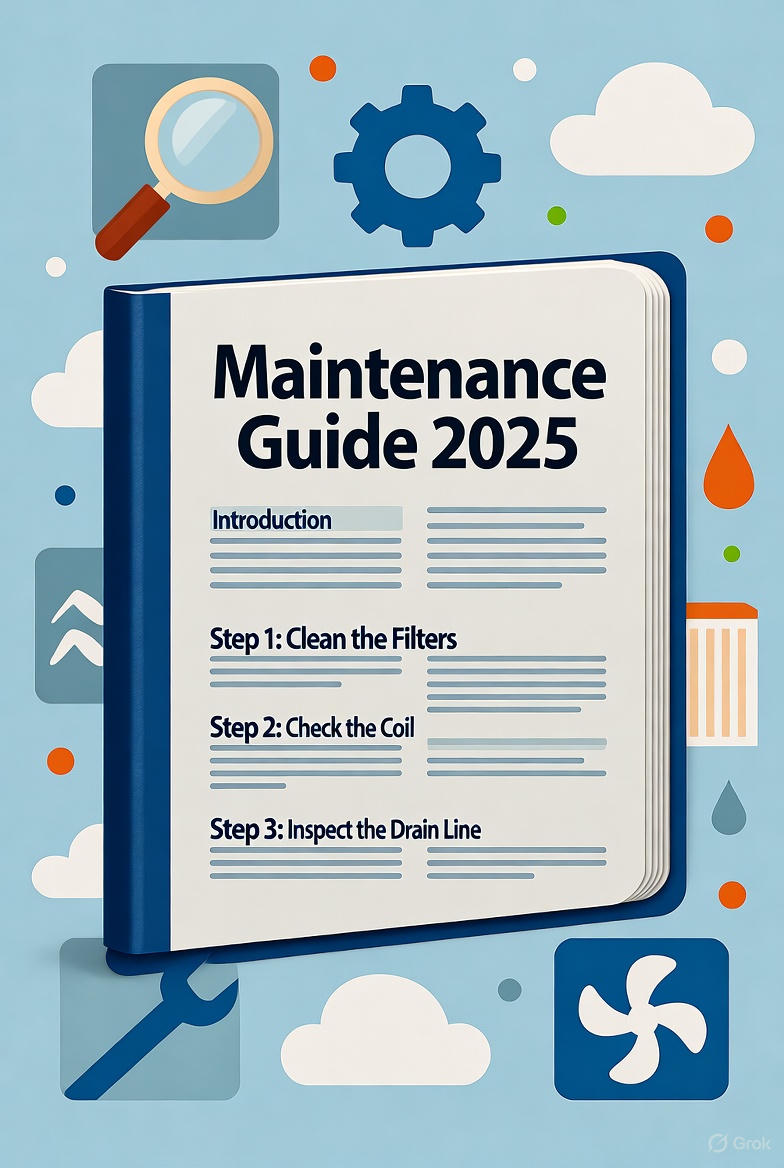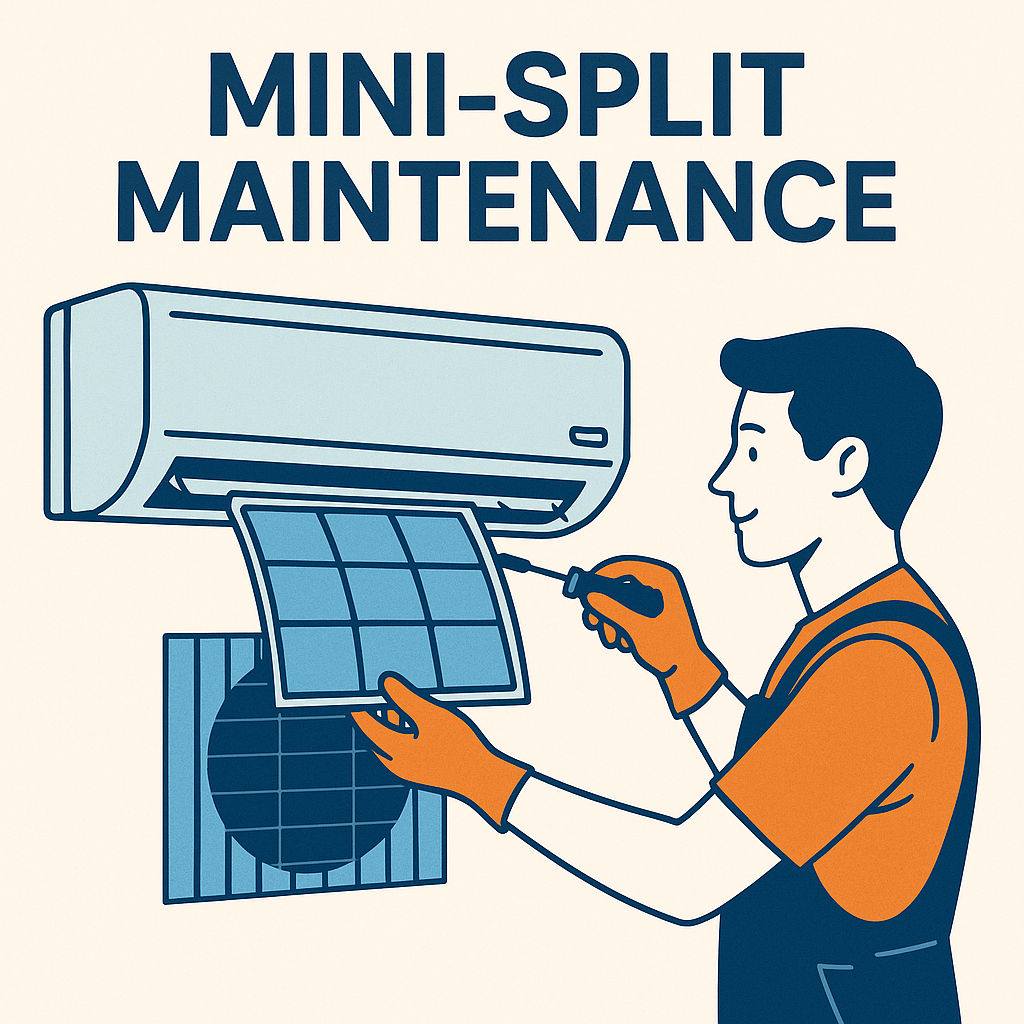Carol forgot filter cleaning for 3 years. Result: Bills jumped $85→$135/mo (59%), year 4 failure, $850 repair, predicted 7-year lifespan.
After maintenance: Bills dropped to $90/mo, saves $540/year, 8 years old but runs like new, on track for 20+ years.
Maintenance ROI: $125/year maintenance = $540 efficiency savings + avoided $850 repairs.

Maintenance Benefits
| With Maintenance | Without Maintenance | |------------------|---------------------| | 20+ year lifespan | 10-15 years | | Normal energy bills | +25-40% bills | | Full capacity | -50% capacity | | Warranty valid | Warranty void | | Clean air | Mold/bacteria |
Cost: Neglect = $1,500-2,500 compressor replacement
Maintenance Schedule
| Frequency | Tasks | Time | |-----------|-------|------| | Monthly | Clean filters, check drain, visual inspection | 5 min | | Quarterly | Deep clean filters, clean exterior, inspect outdoor unit | 15 min | | Semi-Annual | Clean indoor/outdoor coils, inspect lines | 30 min | | Annual | Professional inspection, refrigerant check, deep clean | $125 |
Monthly: Filter Cleaning (5 min)
Why: Dirty filters = -40-60% airflow, -25-35% capacity, +15-25% energy use, frozen coil, allergens
Process:
- Power off → Remove panel → Slide out filters
- Vacuum both sides with brush attachment
- Wash under warm water (mild soap if needed)
- Air dry 30-60 min (NEVER reinstall wet—causes mold)
- Reinstall → Replace panel → Power on
Clean more often if: Pets (weekly), pollen season (weekly), remodeling (weekly) Replace filters: $15-30 if damaged
Condensate Drain & Inspection
Drain check: Verify water drips during cooling. Clear clogs: 1/4 cup vinegar → wait 30 min → flush with warm water. Call pro if blocked/overflowing.
Indoor checklist: No noise, cold air, no ice, responds to remote, no odors, no leaks Outdoor checklist: Fan spins, no debris, 12" clearance, no vibrations, lines intact
Quarterly (15 min)
- Deep clean filters: Soak 15 min in soapy water, scrub, antibacterial spray
- Wipe indoor unit exterior with damp cloth
- Vacuum vents and louvers
- Clear outdoor unit debris, vegetation, straighten bent fins
Spray fins: Low pressure hose, inside→outside, no pressure washer
Semi-Annual (30 min)
Spring/Fall:
- Clean indoor coils: Spray cleaner ($10-20), wait 10-15 min, wipe, air dry
- Clean outdoor coils: Vacuum, spray cleaner, rinse low pressure
- Add drain pan tablets (prevents algae, lasts 3-6 months)
- Inspect fan motor, electrical connections, insulation
- Test heating (fall) or cooling (spring) mode
Annual Professional ($100-200)
What pros check:
- Refrigerant pressure, leaks, charge
- Electrical: voltage, amperage, contacts, capacitors
- Mechanical: compressor, fan, bearings
- Efficiency: airflow, temperature differential
- Deep cleaning: chemical coils, drain lines, blower
Schedule: Spring or Fall | Cost: Single $100-150, Multi $150-250
Troubleshooting
| Issue | Check/Fix | Call Pro If | |-------|-----------|-------------| | Won't turn on | Batteries, breaker, disconnect switch | Still dead | | Poor cooling | Clean filters, clear outdoor unit, lower temp | Ice re-forms after melt | | Water leak | Clean filters, clear drain (vinegar + vacuum) | Leak persists | | Rapid cycling | Clean filters/coils, raise temp | Continues | | Musty smell | Deep clean coils, run fan 30 min after cooling | Persists | | Burning smell | Turn off immediately, check for debris | Any smell | | Chemical smell | Turn off immediately (refrigerant leak) | Always | | Grinding noise | Turn off (bearing failure) | Always | | Rattling | Tighten panels, clear debris | Internal noise |
Lifespan Tips
Do: Clean filters monthly, maintain clearances (12" outdoor, 6" indoor), use AUTO fan, annual pro service Don't: Skip filters (-50% lifespan), ignore issues, block units, DIY refrigerant
Cost Summary
DIY: $75-135/year (cleaners, filters, tablets) Professional: $100-350/year (single to quad-zone) Repairs: Capacitor $150-300, Motor $300-600, Compressor $1,500-2,500 ROI: Maintenance $100-150/year vs neglect $500-1,500/year repairs = saves $400-1,350/year
Warranty
Requirements: Annual pro maintenance, keep records, proper install, register within 60-90 days Coverage: Parts 5-10 years, compressor 7-12 years, Zone offers 10-year warranty Voids: DIY refrigerant, improper install, no records, wrong parts
Seasonal Checklist
Spring: Clean/deep clean coils, test cooling, check drain, pro service Summer: Monthly filters, monitor bills, check drain weekly Fall: Clean/deep clean coils, test heating, inspect insulation, pro service Winter: Monthly filters, clear snow, monitor performance
FAQs
How often should I clean filters?
Monthly for normal use. Weekly if: pets, high dust, or smokers. Takes 5 min: vacuum, rinse, air dry. Prevents 80% of problems. Zone filters are washable—no $15-30/month replacement cost.
Do I need professional maintenance?
Yes—$100-150/year catches issues DIY misses (refrigerant, electrical, deep clean). Required for warranty. Saves compressor failure ($2,000+). Ensures 20+ year lifespan vs 10-12 DIY-only.
What if I skip maintenance?
2-3 months: -15-25% capacity (reversible). 6-12 months: -30-40% capacity (pro clean needed). 2-3 years: compressor damage, $850+ repair, -50% lifespan.
Can I use a pressure washer?
No—damages fins, forces water into electrical. Use garden hose low pressure, inside→out. Pro cleaning $75-100 vs $800-1,500 replacement after pressure washer damage.
Does my system need refrigerant?
Signs: ice on coil, poor cooling, hissing, high bills. But mini-splits are sealed—low refrigerant = leak (call pro). DIY illegal (EPA). Zone systems last 15-20+ years without refrigerant service. Call (801) 882-2324 for warranty help.
Does maintenance really extend lifespan?
Yes. Well-maintained: 18-22 years. Neglected: 8-12 years. Dirty systems run 280 hr/month vs 180 hr/month clean = 2-3x faster wear. $125/year maintenance ($2,500/20 years) saves $5,000-7,000 by doubling lifespan.
The Bottom Line
Monthly 5-min filter cleaning prevents 80% of problems. Set reminder NOW.
Action plan: Monthly filters → Spring/fall deep clean → Annual pro service ($100-150)
Result: 20+ year lifespan, -30% energy vs neglect, warranty valid
Questions? Call Zone: (801) 882-2324
Related Resources:


